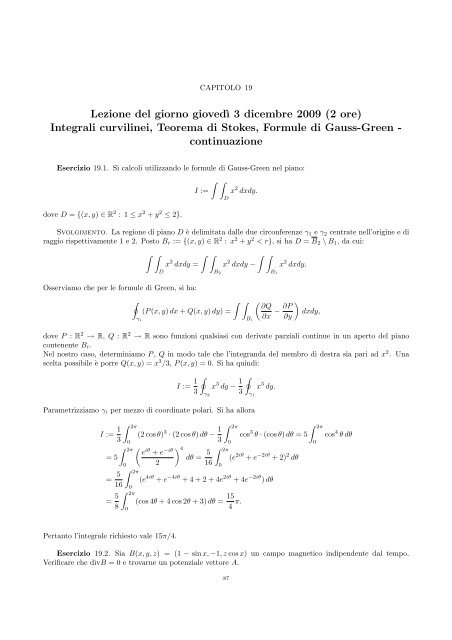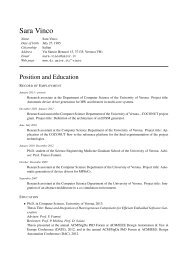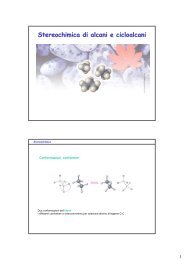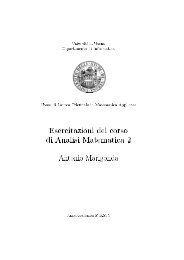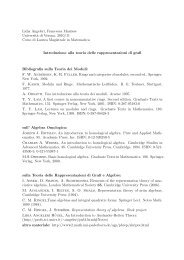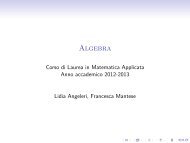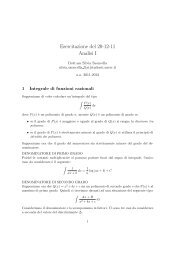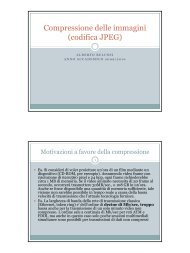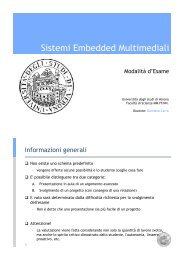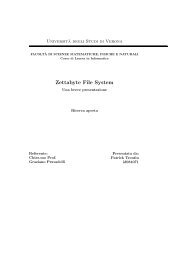Create successful ePaper yourself
Turn your PDF publications into a flip-book with our unique Google optimized e-Paper software.
CAPITOLO 19<br />
Lezione del giorno giovedì 3 dicembre 2009 (2 ore)<br />
Integrali curvilinei, Teorema di Stokes, Formule di Gauss-Green -<br />
continuazione<br />
Esercizio 19.1. Si calcoli utilizzando le formule di Gauss-Green nel piano:<br />
dove D = {(x, y) ∈ R 2 : 1 ≤ x 2 + y 2 ≤ 2}.<br />
<br />
I :=<br />
D<br />
x 2 dxdy.<br />
Svolgimento. La regione di piano D è delim<strong>it</strong>ata dalle due circonferenze γ1 e γ2 centrate nell’origine e di<br />
raggio rispettivamente 1 e 2. Posto Br := {(x, y) ∈ R 2 : x 2 + y 2 < r}, si ha D = B2 \ B1, da cui:<br />
<br />
D<br />
x 2 <br />
dxdy =<br />
Osserviamo che per le formule di Green, si ha:<br />
<br />
γi<br />
B2<br />
x 2 <br />
dxdy −<br />
<br />
(P (x, y) dx + Q(x, y) dy) =<br />
Bi<br />
∂Q<br />
∂x<br />
B1<br />
x 2 dxdy.<br />
<br />
∂P<br />
− dxdy,<br />
∂y<br />
dove P : R 2 → R, Q : R 2 → R sono funzioni qualsiasi con derivate parziali continue in un aperto del piano<br />
contenente Bi.<br />
Nel nostro caso, determiniamo P , Q in modo tale che l’integranda del membro di destra sia pari ad x 2 . Una<br />
scelta possibile è porre Q(x, y) = x 3 /3, P (x, y) = 0. Si ha quindi:<br />
I := 1<br />
<br />
x<br />
3 γ2<br />
3 dy − 1<br />
<br />
x<br />
3 γ1<br />
3 dy.<br />
Parametrizziamo γi per mezzo di coordinate polari. Si ha allora<br />
I := 1<br />
3<br />
= 5<br />
= 5<br />
16<br />
= 5<br />
8<br />
2π<br />
0<br />
2π<br />
Pertanto l’integrale richiesto vale 15π/4.<br />
(2 cos θ) 3 · (2 cos θ) dθ − 1<br />
3<br />
4<br />
iθ −iθ e + e<br />
dθ =<br />
2<br />
5<br />
16<br />
2π<br />
0<br />
2π<br />
cos 3 θ · (cos θ) dθ = 5<br />
(e 2iθ + e −2iθ + 2) 2 dθ<br />
0<br />
0<br />
2π<br />
(e<br />
0<br />
4iθ + e −4iθ + 4 + 2 + 4e 2iθ + 4e −2iθ ) dθ<br />
2π<br />
0<br />
(cos 4θ + 4 cos 2θ + 3) dθ = 15<br />
4 π.<br />
2π<br />
0<br />
cos 4 θ dθ<br />
Esercizio 19.2. Sia B(x, y, z) = (1 − sin x, −1, z cos x) un campo magnetico indipendente dal tempo.<br />
Verificare che divB = 0 e trovarne un potenziale vettore A.<br />
87


